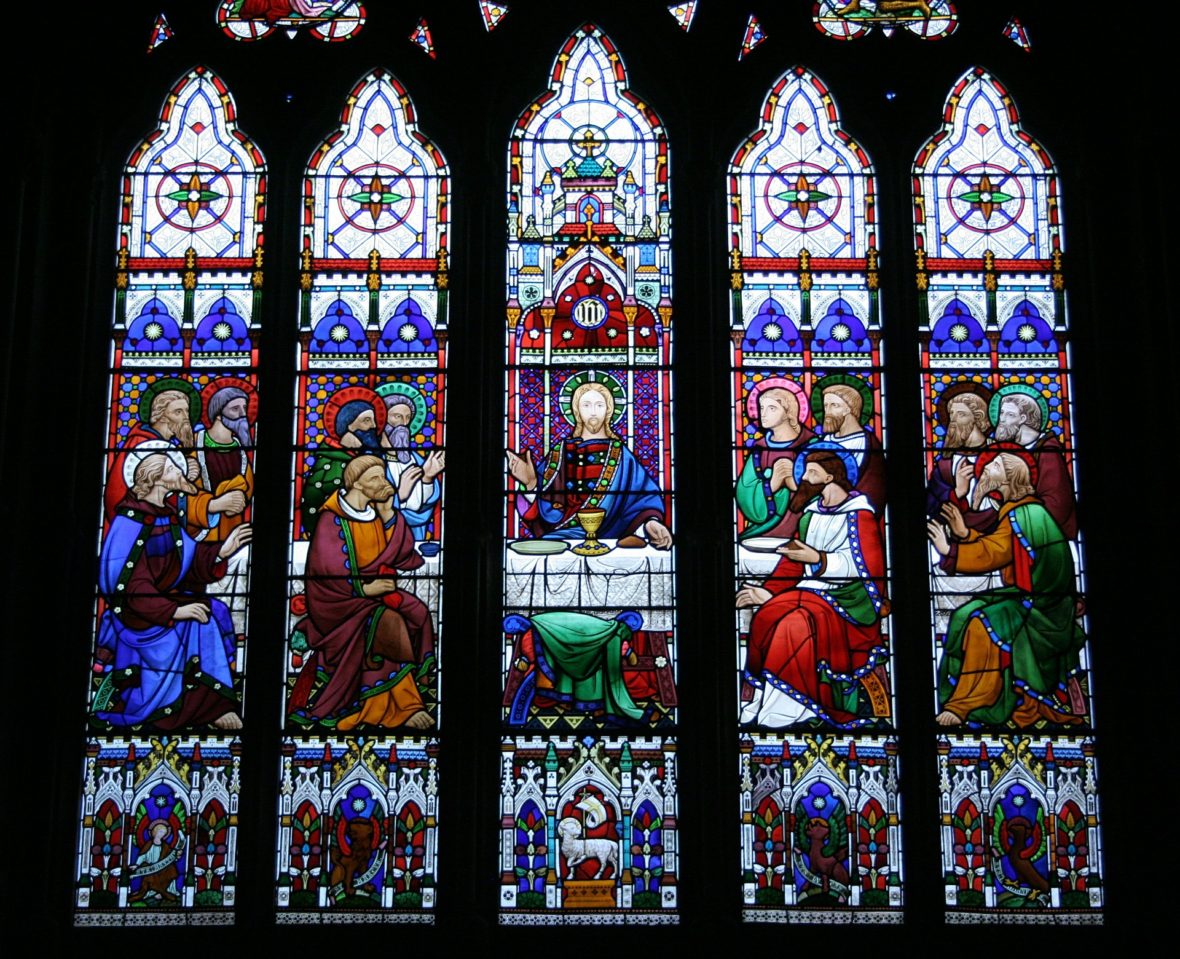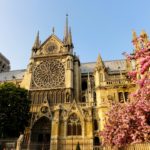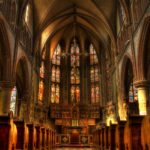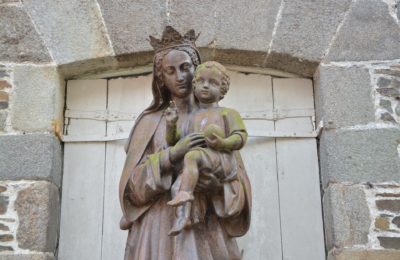Down in adoration falling,
Lo! the sacred Host we hail,
Lo! oe’r ancient forms departing
Newer rites of grace prevail;
Faith for all defects supplying,
Where the feeble senses fail.
To the everlasting Father,
And the Son Who reigns on high
With the Holy Spirit proceeding
Forth from each eternally,
Be salvation, honor, blessing,
Might and endless majesty.
Amen.
~Tantum Ergo by St. Thomas Aquinas (b. 1225- d. 1274)
Today is Holy Thursday in the Roman Catholic Church, the Thursday of Holy Week. In his book, The Liturgical Year, Dom Prosper Gueranger (b. 1805- d. 1875), offers details about this day; he writes:
Jesus is in the Supper chamber, where the Paschal Lamb is to be eaten. All the Apostles are with Him; Judas is there, also, but His crime is not known to the rest. Jesus approaches the table, on which the Lamb is served. His Disciples stand around him. The ceremonies prescribed by God to Moses are religiously observed. At the beginning of the repast, Jesus speaks these words to His Apostles: With desire I have desired to eat this Pasch with you, before I suffer (St. Luke, xxii. 15). In saying this, He does not imply that the Pasch of this year is intrinsically better than those that have preceded it; but, that it is dearer to Him, inasmuch as it is to give rise to the institution of the new Pasch, which He has prepared for mankind, and which He is now going to give them as his last gift: for as St. John says, having loved His own who were in the world, He loved them unto the end (St. John, xiii. 1)…
The Mass of Maundy Thursday is one of the most solemn of the Year; and although the Feast of Corpus Christi is the day for the solemn honouring the mystery of the Holy Eucharist, still, the Church would have the anniversary of the Last Supper to be celebrated with all possible splendour. The colour of the vestments is white, as it is for Chrismas Day and Easter Sunday; the decorations of the Altar and Sanctuary all bespeak joy: and yet, there are several ceremonies during this Mass, which show that the holy Spouse of Christ has not forgotten the Passion of her Jesus, and that this joy is but transient. The Priest entones the Angelic Hymn, Glory be to God in the highest! and the Bells ring forth a joyous peal, which continues during the whole singing of the heavenly Canticle: but, from that moment, they remain silent, and their long silence produces, in every heart, a sentiment of holy mournfulness. But why does the Church deprive us, for so many hours, of the grand melody of these sweet bells, whose voices cheer us during the rest of the year? It is to show us, that this world lost all its melody and joy when its Saviour suffered and was crucified. Moreover, she would hereby remind us, how the Apostles, (who were the heralds of Christ, and are figured by the Bells, whose ringing summons the Faithful to the House of God,) fled from their Divine Master and left him a prey to His enemies.
The Holy Sacrifice continues as usual; but at the solemn moment of the Elevation of the Holy Host and the Chalice of Salvation, the Bell is silent, and, outside the Church, there is not given to the neighbourhood the usual signal of the descent of Jesus upon the Altar. When the time of the Holy Communion is near, the Priest does not give the Kiss of Peace to the Deacon, who, according to the Apostolic tradition, should transmit it, by the Subdeacon, to those that are about to communicate. Our thoughts turn to the traitor Judas, who, on this very day, profaned the sign of friendship by making it an instrument of death. It is out of detestation for this crime, that the Church omits, today, the sign of fraternal charity, it would too painfully remind us of sacrilegious hypocrisy.
Another rite, peculiar to today, is the Priest’s consecrating two Hosts during the Mass. One of these he receives in Communion; the other he reserves, and reverently places it in a Chalice, which he covers with a veil. The reason of this is, that, tomorrow, the Church suspends the daily Sacrifice. Such is the impression produced by the anniversary of our Saviour’s Death, that the Church dares not to renew, upon her Altars, the immolation which was then offered on Calvary: or rather, her renewal of it will be by the fixing all her thoughts on the terrible scene of that Friday Noon. The Host reserved from today’s Mass, will be her morrow’s participation. This rite is called the Mass of the Presanctified, because, in it, the Priest does not consecrate, but only receives the Host consecrated on the previous day. Formerly, as we shall explain more fully further on, the holy Sacrifice was not offered up on Holy Saturday, and yet the Mass of the Presanctified was not celebrated, as it was on the Friday…
…As soon as Vespers are over, the Celebrant returns to the Sanctuary, assisted by the Deacon and Subdeacon. He goes to the altar, and takes off the cloths and ornaments. This ceremony signifies the suspension of the Holy Sacrifice. The altar should be left in this denuded state, until the daily offering can again be presented to the Divine Majesty…. He is now in the hands of his enemies.. who are about to strip him of his garments, just as we strip the Altar. He is to be exposed naked to the insults of the rabble…
The Catholic information website, Fisheaters, describes some customs of this holy day:
This day, Maundy Thursday (also “Holy Thursday” or “Shire Thursday”) commemorates Christ’s Last Supper and the initiation of the Eucharist. Its name of “Maundy” comes from the Latin word mandatum, meaning “command.” This stems from Christ’s words in John 13:34, “A new commandment I give unto you.” It is the first of the three days known as the “Triduum,” and after the Vigil tonight, and until the Vigil of Easter, a more profoundly somber attitude prevails (most especially during the hours between Noon and 3:00 PM on Good Friday). Raucous amusements should be set aside…
…As to customs, many Catholics have a practice of visiting the tabernacles of seven churches altogether, starting on this day and on through Holy Saturday, as a sort of “mini-pilgrimage.” In Rome, the list of the seven churches was chosen centuries ago and consists of the Basilica di San Giovanni in Laterano; Basilica di San Pietro in Vaticano; Basilica di San Paolo fuori le mura; Basilica di Santa Maria Maggiore; Basilica di San Lorenzo fuori le mura; Basilica di Santa Croce in Gerusalemme; and Santuario della Madonna del Divino Amore. Outside of Rome, any seven Catholic churches would do. Some families visit the churches directly after the evening Mass; others go home and wake up in the middle of the night to make the visits…The spirit of the visits to the churches is keeping vigil in the Garden of Gethsemane while Jesus prayed before His arrest…On this day, one may gain a plenary indulgence, under the usual conditions, by reciting the Tantum Ergo (Down in Adoration Falling). (source, Fisheaters)
Have a blessed Holy Thursday.
~SCF
~Additional Holy Thursday reading: Matins for this day, mournful.






